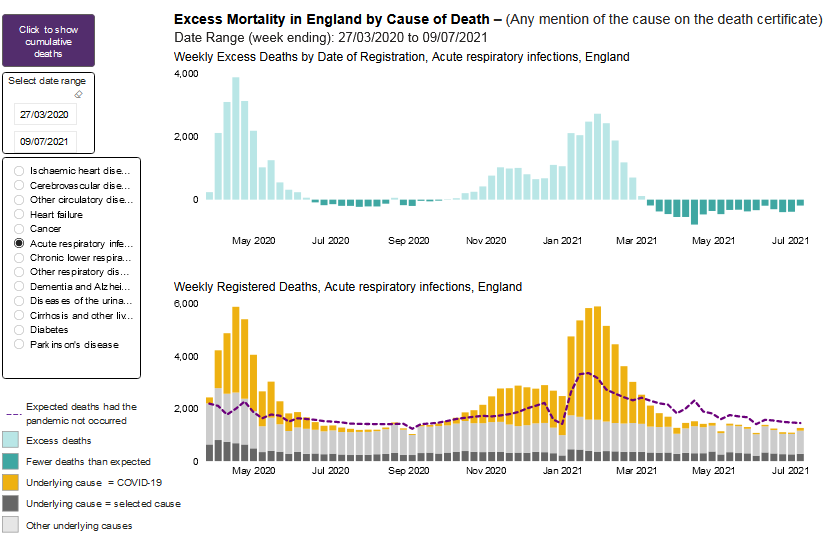Continuing the discussion from Excess deaths from covid vaccine - where are they?:
Hi ED
just trying to get back to this topic that you’ve raised a couple times now. I have a couple of questions as I’m trying to understand your reasoning here.
I’m not sure I get this point. How do we already know this?
So are you suggesting that any shortfall in death for a given category (acute respiratory infection for example) means that those deaths were mis-attributed to covid? Keeping the acute respiratory infection category as an example, does that mean that if the 5 year average for November 20th (say) was 2000 deaths, and we only recorded 1000 deaths on 20-Nov-2020, then that “missing” 1000 were incorrectly pushed into the Covid category, thereby inflating the Covid deaths but artificially deflating acute respiratory infection deaths?
I’m trying to follow the main thrust of your argument, so please correct me if I’ve already got it wrong…I’m probably missing an important point here. I’ll continue my thoughts on that when I feel like I’ve understood you better.
Moving on,
Interesting thought. Firstly we would have to agree that a large number of deaths must have occurred for this to happen. That’s a point of agreement at least - a lot of people died of covid. (Perhaps even enough to skew the life expectancy in England  ). Whether that would affect the 5-year average enough to hide any vaccine deaths is debatable. It depends on how many vaccine deaths there were. If the number is really in the 10s of thousands then I would still expect that to be visible. I haven’t gone through the trouble of reproducing the 5 year average and checking, but it would be an interesting exercise to do when I have time. Certainly some of the figures that have popped up on this forum from places like VAERS are coming up with deaths in the 10s - 100s of thousands (even millions, worldwide). There is nowhere for numbers that big to hide… I would expect to see them in the all cause mortality. Additionally, between March and June 2020, we officially recorded something like 40K deaths UK wide, less than a third of the total official Covid death toll so far. I’m really not sure that’s enough to hide 10s of thousands of vaccine deaths in 2021.
). Whether that would affect the 5-year average enough to hide any vaccine deaths is debatable. It depends on how many vaccine deaths there were. If the number is really in the 10s of thousands then I would still expect that to be visible. I haven’t gone through the trouble of reproducing the 5 year average and checking, but it would be an interesting exercise to do when I have time. Certainly some of the figures that have popped up on this forum from places like VAERS are coming up with deaths in the 10s - 100s of thousands (even millions, worldwide). There is nowhere for numbers that big to hide… I would expect to see them in the all cause mortality. Additionally, between March and June 2020, we officially recorded something like 40K deaths UK wide, less than a third of the total official Covid death toll so far. I’m really not sure that’s enough to hide 10s of thousands of vaccine deaths in 2021.
I don’t think I follow you here. What extra deaths following vaccination? Covid deaths? Think I’m missing something…
This is precisely the point I was raising. If thousands of people are dying because of the vaccines, then however they are being categorised, they should show up in all-cause mortality. Given that all-cause mortality was coming down as the vaccine program was ramping up then I’m left wondering where these deaths are hiding?
Sorry for the all the questions. Hoping that you can help me get to the main point you’re making here.
Cheers
PP


 ) as many countries went through a second peak before their vaccination programme could affect much of their population. So if they then registered high vaccination rates and low covid deaths after the curve came down, it would be hugely flattering to the vaccines. This happened in the UK and US for example - thoughthey weren’t included in the correlation.
) as many countries went through a second peak before their vaccination programme could affect much of their population. So if they then registered high vaccination rates and low covid deaths after the curve came down, it would be hugely flattering to the vaccines. This happened in the UK and US for example - thoughthey weren’t included in the correlation.